The Power of Positive Self-Criticism in Art
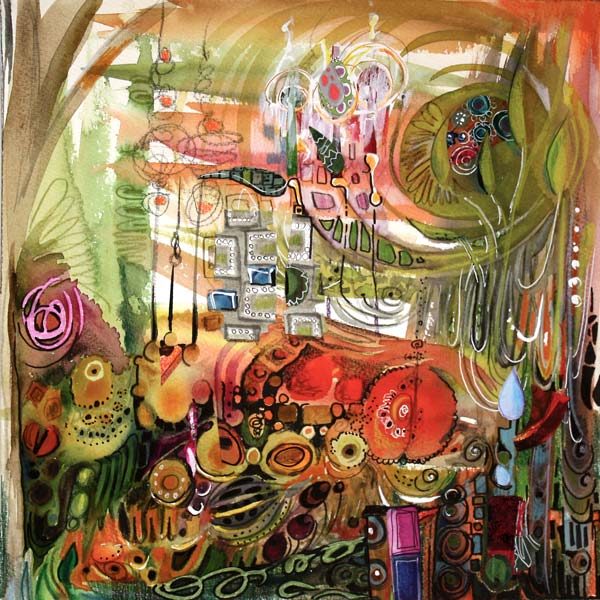
My latest mixed media artwork is called “Positivity Grows”. It is dedicated to all of you who have a strong inner critic. If you want to improve, it is essential to evaluate your own work. But sometimes the self-criticism can have too negative tone. Have you experienced any of these?
1) Big Picture Panic
The artwork gets evaluated as a whole in a too early stage. It is like making a meal and after tasting the raw potatoes, you’d decide that it’s not going to succeed. “I must have done something wrong when peeling those potatoes!”
2) Overclean Obsession
You take the safe way: you don’t mix colors, don’t let anything intersect, draw sloo-owly, keep everything plain, simple and controlled. This reminds me of a tadpole (a baby frog) which I got from my friend when I was a child. The tadpole lived in a jar filled with muddy water. I picked a clean vase, poured plenty of tap water and put the little frog there. It did not live long. I did my best to take care of it but did not understand that for the tadpole, there was nothing to eat, nowhere to hide. So – Mix those colors! Add diversity! Give some nourishment to the growing artist in you!
3) Mistake Hunt
If you focus on the things that “went wrong” instead of those which “went right”, you are playing the wrong game. Art is in small nuances, it requires sensitivity and openness. If your self-evaluation is too negative, you do not notice the beautiful little details that appear in your art. They are often lucky accidents if you take care of the diversity. When enhanced, those details can take over and bring your end result to the new level.
Positive Self-Criticism
You can get cured of any of those diseases with a healthy dose of positive self-criticism. From the moment you make the first brush stroke, focus on the details and look for beautiful and interesting areas. I will show you how I did that while creating the artwork of this post.
Phase 1 – Watercolors
When I began the artwork of this post, I just made a mess with watercolors. I kind of made the muddy jar for tadpoles to prosper!
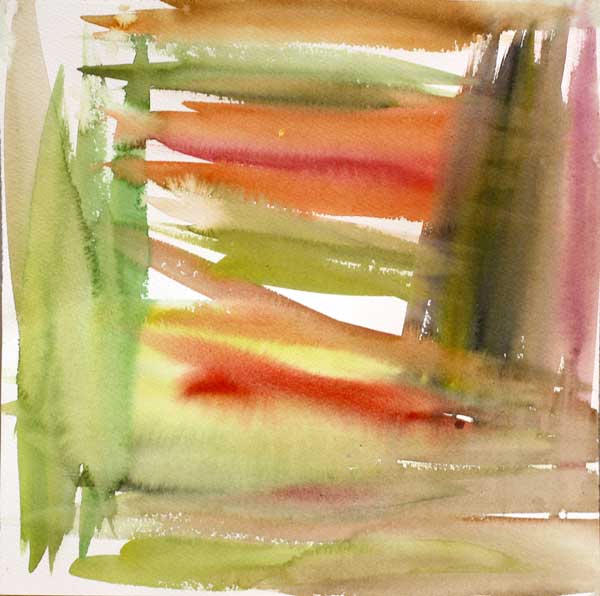
After painting this, I could have just quitted and called it ruined. Or I could have tried to make that dark muddy area brighter. But instead, I began to investigate the painting closely.
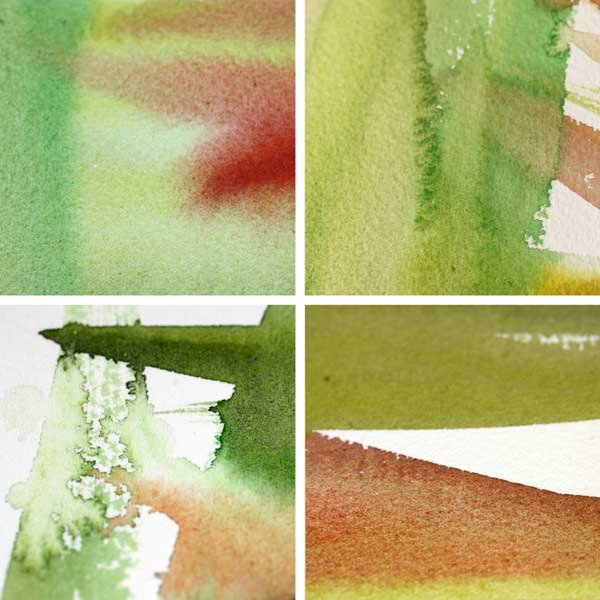
My inner critic pointed the little details with so much beauty that I began to feel confident and excited. The whole process of making this artwork began to feel like an adventure. Instead of mistakes, I was hunting treasures!
Phase 2 – Watercolors
Next, I continued with watercolors and created new layers of elements. I took care of the diversity: there’s a lot of various hues and shapes. And even more important: the layers intersect so that they create new happy accidents.
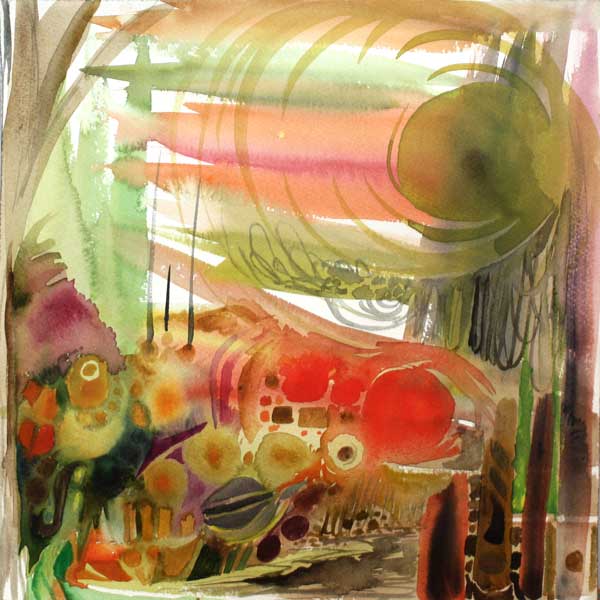
After painting this, I enjoyed this tiny detail: a yellow spot. It was like a little star! I felt I was lucky and genius at the same time.
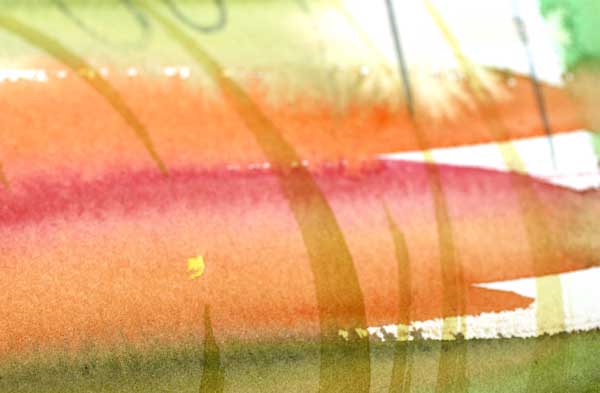
I spent some time searching for more beautiful areas and enjoying them. With watercolors, the edges of brush strokes are often really beautiful.

Phase 3 – Colored Pencils
To keep the diversity level high, I changed watercolors to colored pencils. I also changed the music I was listening to. Working from a small area to another, I enlarged the beautiful details found after another.
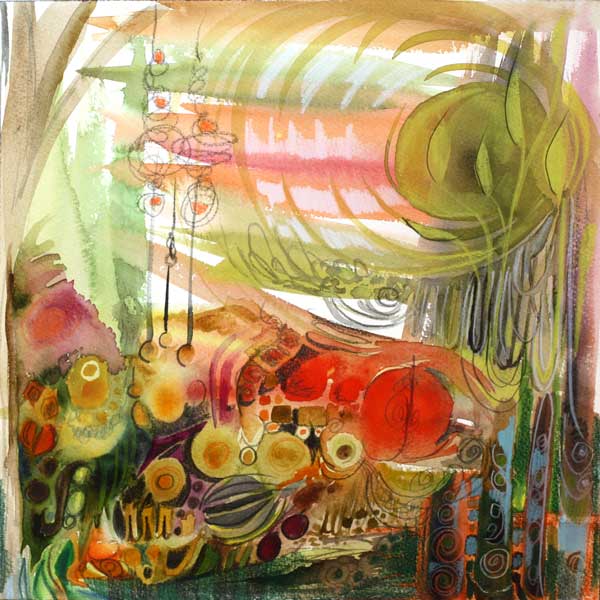
In this phase I realized that the main theme of the artwork would be growth. I searched for the details that would express the theme. I found several and they made me happy!
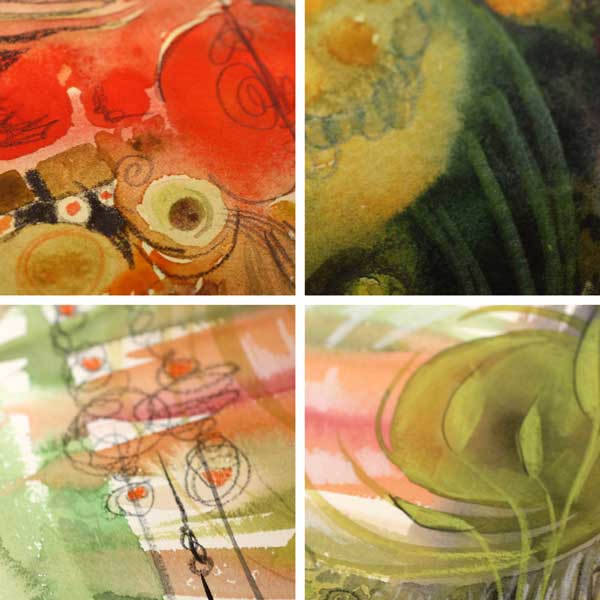
Phase 4 – Pens
New music and new supplies! This time I picked a black PITT Artist Brush Pen and a white gel pen (Uni-Ball Signo). I was encouraging myself to create strong contrasts. They would make the pretty details really pop. Again, I was not worrying about hiding the not-so-pretty details but enhancing the good ones.

In this phase I began to look the artwork as a whole. However, instead of correcting the poor composition, I analyzed which of the details looked most appealing and how they were located.
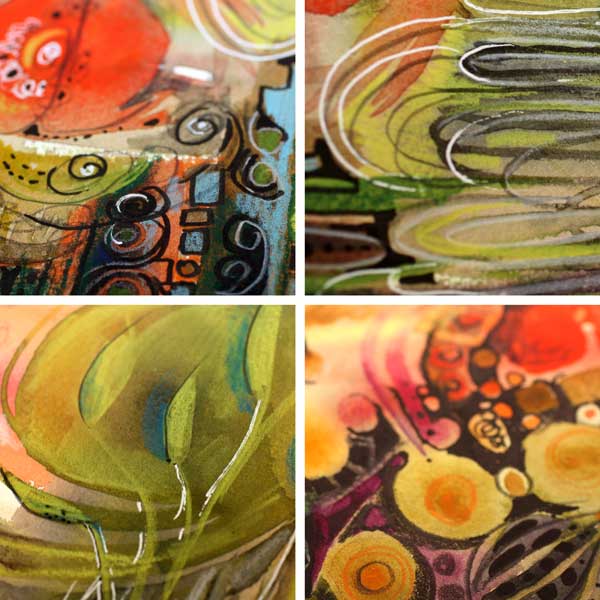
Phase 5 – Finishing
When finishing, I like to listen to the rhythmic music which gives me the confidence to carefully adjust the balance of the work. I picked a white correction pen and a box of hand decorated papers. By doodling and cutting papers, I changed the composition so that the eye would find all the pretty little details one by one.
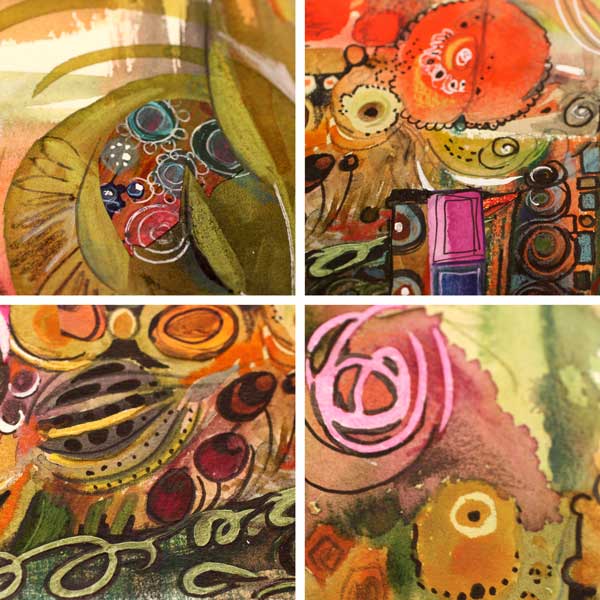
The Summary
You can be analytical and critical when making art. You can also be strict: mix the colors, change the tempo, keep the image alive! But maintaining the gentleness and sensitivity is crucial too. Let the little details that appeal to you be the foundation for your self-expression!

Blank Page Syndrome before Big Picture Panic?
Buy the video “Watercolor 101 for Intuitive Painting” where I will show you how you can get a fast start and keep going! Click here for the preview!
22 thoughts on “The Power of Positive Self-Criticism in Art”
Comments are closed.
This is the wisest post ever about art and artists! You are so brilliant at analyzing things and then passing that information along. This painting is very beautiful and I could gaze upon it for a long time to find peace and relaxation. (I did notice a tiny quail towards the bottom left side under the rose in front of the tree.) Something inside of you has influenced you to pass along to others your love of art and of making art and I am so grateful.
Thank you for your lovely comment, Mary!
What a great post! I like that you shared all your creative process.
In fact, this painting is one of my prefered from you!
Thanks, Louise! Great to hear!
I often feel I am making a muddy mess when starting the way you did…and it truly ends up “looking” like. Muddy mess. I do love
Your style!
Thanks, Mimi! Keep on stopping between the layers and searching for the things you want to enhance!
You are a treasure Paivi. Thank you for the beauty in your honesty and your wonderful art. We all so need it.
Thank you so much, Nea!
Such a beautiful painting. It is hard to imagine you were ever anything but thrilled with it. Great post.
Thanks, Sandi!!
BEAUTIFUL!! You are so blessed with this talent!
Thank you, Bonnie!
Thank you so much……fantastic advice, especially the story of the tadpole. I now feel empowered to take a different approach. I am a huge fan of your work….absolutely stunning.
Thank you, Marguerite!
Paivi you are so thoughtful in your advice- making sure it benefits others! I love how yourelate art experiences to real life happenings (like the potato)!! Thank you
Thanks, Paula!
Ihana postaus kertakaikkisesti.. Katselin sen eilen autopesussa. Enkä voinut mitään –en ole aikaisemmin mieleistäni onnistunut saamaan, olen liian hätäinen ja lyhyt pinnainen. Nyt pyrin noudattamaan kertomiasi vaiheita. Ja hei mäkin osaan… Kiitos siis, laitan postaukseen linkin sivullesi. Olet aarre <3
Kiitos, Anu-Riikka – Thank you!!
I’m back again to view this and have a little relaxation break. It makes me so happy to look and you do something I want to be able to do but somehow never do it. You said let the eye discover each tiny detail. When I paint a tiny detail I like – I paint them all over. I just can’t stop enjoying the process but it limits the viewer and even me from enjoying those individual tiny details – too much of a good thing. One thing I wish to accomplish next year is the ability to make “a tiny detail” and leave it for discovery. Then repeat with a completely different detail. So hard yet so wonderful. It will be a good exercise to practice. Happy New Year.
Mary, thank you for the great comment! Leave those tiny details, let every layer speak. Great goal! Happy new year!
I read this today, and used your wisdom when I went back to work on a journal page I had painted a few weeks ago. It was supposed to be loose, abstract flowers, but it ended up being watercolor blobs. Another artist suggested I revisit it with ink and colored pencils, and so after reading this post I looked at what I had. I found spots and areas of beautiful interplay between colors and between paint and paper (some lovely edges) so I played those up, added color, did pen work, and then accented everything with white ink. Now I love it! Thank you for the wisdom of this post. I’m going to share it at my watercolor class this week.
Amy, thank you! How wonderful to hear! I wrote this blog post because if we do not see beauty in the beginning, how could it macigally appear in the end. Creating art is so much about tiny nuances we often omit. I also think that the attitude of seeing beautyful spots affects not only our art but the way we see life.